
Etomoiditis is a pathological process that is characterized by inflammation of the mucous membrane of the cells of the latticed labyrinth. This labyrinth is a component of the paranasal sinus and the latticed bone, which is concentrated in the depth of the skull at the base of the nose. The disease can occur alone or in combination with other concomitant sinusitis.
Contents
- 1 What is this disease
- 2 Species
- 2.1 Acute illness
- 2.2 Chronic
- 2.3 Catarrhal
- 2.4 Polyposis
- 2.5 Purulent
What is this disease
Etnoyidit is a disease that can be of bacterial or viral origin. Classify it into two main types - acute and chronic.
Acute etimoiditis is formed against a background of acute rhinitis or influenza. Most often the inflammatory process, which takes place in other paranasal sinuses, leads to repeated damage to the trellis labyrinth. If the inflammation struck the maxillary and frontal sinuses, then the lesion can be applied to the anterior cells of the latticed bone.
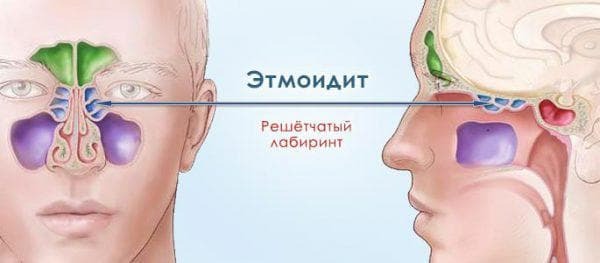
In the photo, the etmoiditis looks like
Inflammation with etmoiditis sharply attacks the deep layers of the mucosa. As a result, edema and diffuse swelling are observed. The hole between the cells of the latticed bone and their outgoing ways are reduced in size. All this leads to drainage.
Considering ethmoiditis, it is necessary to note the main reasons for its formation. Affect the development of the disease can viruses and bacteria, which weaken the defenses of the body and nasal mucosa.
Etomoitis may occur for the following reasons:
- rhinitis and colds, as well as all ailments of viral etiology;
- sinusitis of various kinds: fungal, viral and bacterial;
- defects of the septum, having an innate and acquired character;
- rhinitis is allergic;
- weakened immunity, unable to combat pathogens;
- trauma to the face.
It is not uncommon for ethmoiditis to occur against the background of influenza and scarlet fever. But still, most often the cause of the development of pathology lies in the neglected frontitis or sinusitis. If the front parts of the latticed bone are inserted into the process, the pathology is called frontoethmoiditis and gaymeroetmoiditis. The posterior areas of the bone are connected to the process when the disease is not treated properly, and it is in a neglected form.
On video detection of the disease with ethmoiditis:
If the inflammatory process struck two nasal sinuses at once, the disease is called pansinusitis or polysynusitis. Here everything depends on which cavities are connected to the inflammatory process.
Adenoid sinusitis is the result of the presence of growth in the nasal cavity. They do not allow the mucus to escape normally from the cells, resulting in excellent conditions for the formation of bacteria. There are certain situations when the ethmoiditis itself becomes the cause of the formation of polyps. Then the pathology takes a chronic form, and the therapy is reduced to performing the operation. In another way to cure the disease does not happen, since abnormal growths do not give a normal recovery of the nose.
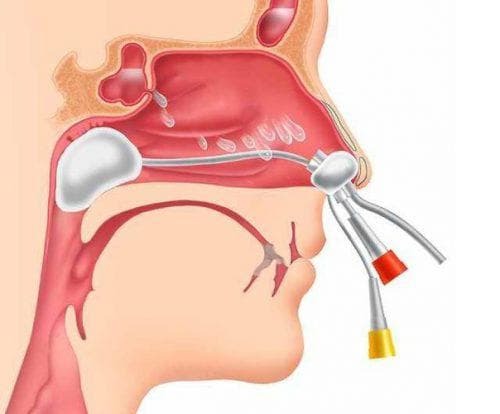
adenoid sinusitis
Compared with the common cold, etmoiditis requires urgent treatment. This is due to multiple causes. First, the ailment in an acute form can flow into a chronic one, which is very difficult to treat. Secondly, etmoiditis in the absence of proper treatment can provoke a number of complications that pose a danger to human life.
The most common complications include:
- violation of the integrity of the trellis labyrinth;
- decreased vision;
- spread of the inflammatory process to the intracranial areas, resulting in complications such as brain abscess or purulent meningitis.
Types of
Ethmoiditis can be classified by flow, etiology and localization of inflammation.
Acute illness
Acute form of the disease has more vivid symptoms, compared with chronic. But only the acute ailment therapy is easier. This is due to the fact that it is possible to recognize the symptoms of pathology as early as possible and begin treatment at the initial stage.
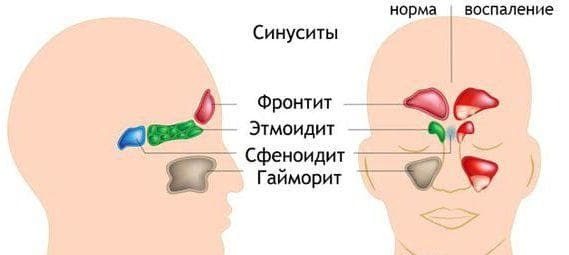
In the photo, the acute etmoiditis
looks. For etmoiditis in acute form, the following symptoms are typical:
- severe pain in the head, concentrated in the region of the nose, forehead and corners of the eyes;
- difficulty breathing;
- smear violation or complete loss of it;
- temperature rise up to 38 degrees.
In addition, with a sharp current of the patient, a strong cold is worried. But the serous, which is separated at the initial stage, that is, there is no pus. Purulent discharge will be observed a little later, when the mucus will be dense green or yellow.
If etmoiditis affects the patient for the first time, then if you consult your doctor in a timely manner, it can be cured quickly and without complications.
And here at repeated defeat to treat an illness is much more difficult, as it quickly flows into a chronic form. As a rule, complications can develop in two days.
 And here is how to treat chronic tonsillitis during pregnancy, and what means should be used, is described in this article.
And here is how to treat chronic tonsillitis during pregnancy, and what means should be used, is described in this article.
How to determine the curvature of the nasal septum, and how to restore the state of the structure of the nose.will help to understand this information.
Which ointment under the nose for a cold for children is the best and most effective, is listed here: http: //prolor.ru/n/ lechenie-n / maz-ot-prostudy-v-nosu.html
What folk remedies for ear coldness with the cold are the most spectacular,link.
Chronic
This form of pathological process is characterized by an unpleasant clinical picture, as well as the presence of complications. Passes the disease in a chronic form due to improper therapy of acute etmoiditis or weak immunity. Chronic etmoiditis can not be completely cured, so it will become a permanent companion. It can flow in two stages - remission and exacerbation.
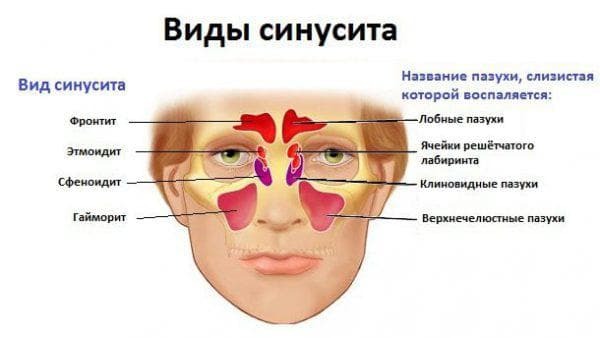
On the photo - chronic etmoiditis
Symptoms during exacerbation are similar to the clinic of the acute phase of ethmoiditis. In the relief phase, the disease occurs without severe symptoms.
But some patients complain of such signs:
- discomfort in the root zone of the nose;
- persistent headaches;
- purulent mucus, coming out of the nose, having a nasty smell;
- concentration of the discharge in the nasopharynx;
- nausea, which can lead to vomiting;
- impaired sense of smell.
Chronic etmoiditis is very dangerous, because with him, a person can live more than one year, believing that he has a chronic cold. The only way to permanently get rid of the chronic form is to perform an operation.
In addition, etmoititis can differ in the location of pathology:
- bilateral - defeat is applied from two sides;
- right-sided - inflammation affects only cells from the right region;
- left-sided - inflammation affects cells from the left region.
Another pathology can vary according to its current:
- catarrhal;
- purulent;
- polyposis.
Catarrhal
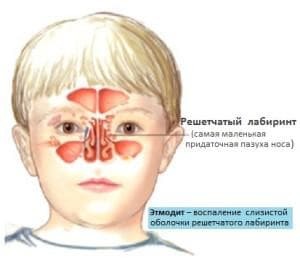
On the photo - catarrhal etmoiditis
The cause of the development of pathology lies in the penetration of the virus. A characteristic feature of catarrhal etmoiditis is lacrimation. The patient complains of symptoms of intoxication - headache, dizziness, general weakness, nausea.
Redness is observed in the white of the eye. There are situations when the bursted vessels are observed in the inner corner of the eye. The edema that hit the bridge of the nose can move to the corners of the eyes. The catarrhal form is characterized by the absence of smell.
Polyposite
This type of ethmoiditis develops in a chronic form of pathology. The cause of development is a prolonged rhinitis. Puffiness affects the mucosa and for a long time does not pass, sometimes affects the latticed bone.

In the photo, the polyposive ethmoidite
looks like. The inner part of the cells amazes the polyps. They block the lumens, as a result of which the mucous membrane is always swollen. Patients may experience remission, during which there are no symptoms. Nasal breathing is restored. But to influence the exacerbation of the common cold.
You may also be interested in knowing which nose spray for allergic rhinitis is best suited.
How to use aloe in the nose with a cold, and how effective this tool is, is described in great detail in this article.
You may also be interested in learning how to use sage from a cough during pregnancy.
What causes the swelling of the nasal mucosa without a common cold are most common, and how such problems can be eliminated is described in great detail in this article.
Purulent
This form of acute etmoiditis is the most complex and dangerous. Its clinical manifestations are pronounced, a temperature rise up to 40 degrees is observed. There is severe pain in the forehead and nose, galls and teeth. The patient has increased lacrimation. It will also be interesting to know why pus appears in the tonsils and purulent plugs.

On the photo-purulent etmoiditis
General condition of the patient worsen general signs of poisoning.
Etomoiditis is a serious disease in which inflammation affects the latticed bone. It can occur in two forms - acute and chronic. Each of them has its own symptoms and methods of therapy. Complications of the pathology are serious enough, therefore, with treatment, it is not necessary to delay.
